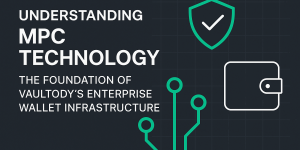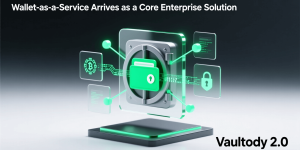Smart Vaults: Introducing Vaultody’s Innovative MPC Solution for Digital Asset Management

Vaultody's Smart Vaults represent one of our most significant milestones to date, the result of months of relentless development by our team. We are thrilled to announce that Smart Vaults are now live and functioning as an integral part of our MPC custodial solutions.
Our Smart Vaults are an innovative type of digital asset wallet (referred to as “vaults” in Vaultody), offering a combination of features and functionalities introduced for the first time on the market. In this article, you will learn what makes Smart Vaults unique and how they compare to our General Vaults. We also suggest different use case scenarios to help you decide on the most appropriate vault type for your business as well as all necessary steps to set up your vaults.
What makes “Smart Vaults” smart?
Smart Vaults are designed to suit the needs of businesses that place a large number of addresses, despite that there are no specific restrictions or requirements in regards to eligibility or suitability.
The technology incorporated into these vaults allows Smart Vault users to attain a range of benefits, including the generation of an infinite number of deposit addresses, giving businesses the freedom to create as many as they need.
Additionally, users can perform batch transactions (currently in development), achieve up to 90% reductions in transaction fees, and eliminate the wallet dust issue - a common problem in the market that can lead to higher losses as the number of addresses increases.
The wallet dust issue is resolved by allowing users to pay just one transaction fee, regardless of the number of transactions or addresses involved. This is achieved through a station address. The station address is placed in the user's main wallet, and all fees are paid from there, addressing and solving wallet dust issues that may occur across all child addresses generated by the client.
All of these features combined significantly improve the user experience and make our Smart Vaults genuinely smart.
Smart Vaults vs General Vaults - Which one to use?
Both types of vaults have different use cases and serve different purposes. This is why it is important to understand the similarities and differences between them.
Regardless of which vault type you choose, you can be confident that you are receiving the most advanced custodial MPC solution on the market. There are no compromises in security, as both products are protected by hardware enclaves, also known as trusted execution environments (TEEs). They both utilize multi-party computing technology, preventing unauthorized access from both internal and external parties.
The Vaultody Approver mobile app is compatible with both vault types, allowing vault owners to approve and reject transaction requests as well as other system actions. Full flexibility and control over funds and funds management are equally impeccable across both vault types.
However, Smart Vaults offer a range of features and use cases that differ significantly from those of General Vaults.
General Vaults are designed for companies that need to store high-value digital assets and conduct relatively few transactions, for two main reasons. Firstly, our transaction policy rule allows multi-level approval for high-value transactions, ensuring better control over funds management. Secondly, for businesses that need to conduct a large number of transactions, our Smart Vaults offer significantly better benefits, as they are crafted to serve these needs.
General Vaults would be well-suited to Hedge Funds and VC firms, for example, as they deal with very large sums but do not execute a high volume of transactions on a daily basis. Additionally, the transaction policy, although also available in Smart Vaults, enables all assigned team members to participate in the multi-approval mechanism of the vault.
On the other hand, Smart Vaults are suitable (but not limited) to exchanges. The high volume of transactions allows Smart Vaults users to achieve transaction fee savings, create batch transactions, save time by completing multiple transactions with just one transaction, pay for all transactions from a station address that resolves digital asset losses in the form of wallet dust, and provide the freedom to generate as many deposit addresses as the client requires, called child addresses.
Setting up your General Vaults & Smart Vaults
Now that you are familiar with the key similarities and differences between the General and Smart vaults, it is time to set up the type of vault that suits your business needs and operational strategy.
Sign-up and access your Vaultody Dashboard
The first step is to open an account and go through the self-onboarding process. Assuming that you have successfully completed this step and your account is up and running and you have access to your Vaultody Dashboard, it is time to get to the second step.
Select Vaults & Create a New Vault
In your user dashboard, locate and select “Vaults” from the navigation pane on the left. Then, proceed to click the green “Create a new vault” button situated on the right side of your display.
Choose Your Vault Type
Upon clicking the “Create a New Vault” button, a pop-up window will emerge, inviting you to choose the type of vault you wish to create. This window provides a concise overview of the use cases and features unique to each vault type. After reviewing the options, select the vault type that best suits your needs and proceed by clicking the “Next Step” button.
Choose Vault Name & Color
The next step will ask you to give your vault a name. You can also select the color of your vault. This will help you make a distinction between your newly created vault and other vaults that you own. Make your selection, put a tick on the “I understand” box and proceed with the final step.
Summary of Your Vault Details
The last step is a summary of the option selections that you have made so far. You will be asked to review the vault type that you selected, the name you have given to your vault, and the vault color that you chose. If you are happy with your selection click on the Create a New Vault, or get back to previous options to edit your information.
Confirmation Pop-Up
Upon successful completion of the previous step, you will see a pop-up confirming that your vault has been created and can now be found in your Dashboard. At this point you can either close the pop-up, or continue with the next mandatory for each vault step - the creation of your Vault Backup. We strongly recommend backing up your vault now.
Vault Backup
As we mentioned, this step is mandatory, and it is best to complete as part of your new vault creation process. Each vault is backed up just once. For that purpose, you will be asked to provide your public key, re-enter it to avoid unintentional mistakes, and then you have to submit for approval. We also encourage you to follow the steps in our Backup and Restore Guide to ensure your backup has been successfully created.
Once your backup is created, you will be all set and you can enjoy the benefits of your vault. Congratulations on completing all steps successfully and unlocking the best protection out there for your funds!
If you are unsure which of the vault types is best for your business case, or if you need any assistance in setting up your vault, please contact our team at [email protected] who will assist you with your inquiries.




 Login
Login







 Copy link
Copy link